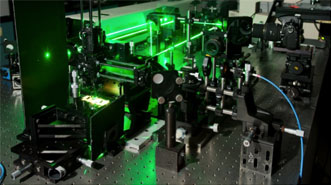
Thin Films Make Certain QDs Glow Brighter
Using thin-film metal oxide substrates for quantum dots could turn them into more efficient light emitters.
A team at the University of Alabama in Huntsville and the University of Oklahoma probed the behavior of four types of quantum dots (QDs) manufactured by chemical synthesis. Some had protective shells; others did not. In addition, some of the dots had cores made of binary materials, while others had ternary-material cores.
The researchers found that ultrathin aluminum oxide made quantum dots glow brighter. The effect was much stronger in QDs that did not have protective shells. And while quantum dots with both binary and ternary cores shrank after reacting with oxygen in the air, ternary-core dots placed on aluminum oxide glowed brighter despite the shrinkage. This could lead to the development of smaller QDs without sacrificing brightness, the team wrote.

To analyze the behavior of quantum dots on aluminum oxides, the researchers illuminated them to make them glow brighter. Courtesy of Dr. Seyed Sadeghi/University of Alabama in Huntsville.
The findings were surprising, said Huntsville professor Dr. Seyed Sadeghi, and the team does not yet have an explanation for the differences. Next, the researchers will investigate how other metal oxides affect the behavior of quantum dots when they are close to metallic nanoparticles.
Previously, the team found that placing quantum dots on nanometer-thin layers of chromium and aluminum oxides significantly altered the dots’ behavior — the aluminum oxide increased their emission efficiency, while the chromium oxide increased the dots’ degradation rate when exposed to air.
The findings could be used to improve sensors, LEDs and photovoltaic devices, as well as fluorescent tags for biomedical imaging and qubits in quantum computing, the researchers said.
The research was published in the Journal of Applied Physics (doi: 10.1063/1.4894445).
For more information, visit www.uah.edu.
Published: September 2014